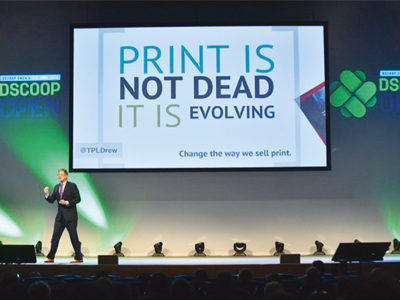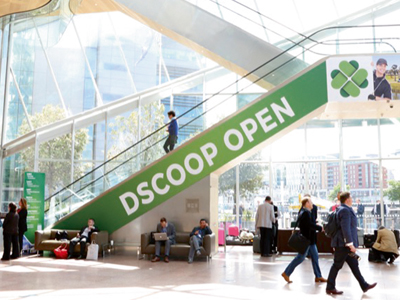Dscoop – the Digital Solutions Cooperative – is the HP graphic arts user network, and has become a global community of print providers that exists with an ethos of sharing knowledge and opportunities. Andy Knaggs visited its latest EMEA-area conference in Dublin.
This article should be of interest to all readers of Digital Printer, whether they use an HP Indigo press or not. The Dscoop Open, the HP user group’s 2015 conference held in June, brought together more than 1200 people – Dscoop members and a good number of exhibiting partners (including of course HP) – at the Convention Centre in Dublin. The attractions of the Irish capital are obvious, and indeed the delegates were treated to a party at the city’s famous Guinness Storehouse, causing many a Friday morning thick head. But there was much in terms of content for them to take away too, and much of what Digital Printer listened to could be applied across the print sector.
The first morning in fact provided food for thought. Gary Peeling, familiar as the managing director at London’s Precision Printing, but also wearing the hat of Dscoop global chairman, provided an introduction in which he articulated the Dscoop ‘values’ of sharing knowledge to get the most from technology, developing and deploying the best applications, and using the network to find solutions. He claimed that Dscoop members are on average 15% more profitable than companies that are not members. However, it was his points regarding the buyers of print that hit home.
‘We’ve spent a lot of time in the last 10 years dealing with professional print buyers and it has got us into some really bad habits,’ he said. ‘We thought we would go to the CMO (chief marketing officer) but his business was asking him to do more for less. We have to think about our audience. Our thinking should be focused on the more creative thinkers, and ways we can surprise and delight them.’
He went on to talk about ‘Generation Z’, which ‘thinks, lives and talks digital’. He said that this young generation wants to use print but is intimidated by the terminology of the industry. ‘They don’t have a mental bridge between the old (paper) world and the new (digital) world. We have got to make the products easier,’ he said. He suggested adapting Apple’s approach: this or that; adequate or better.
‘The core message is that digital print drives deeper and closer engagement. We need to drop the how-to lingo. There is rising demand from brands to engage with consumers and that’s what digital print does.’
Mr Peeling was followed by the first of two keynotes, one to open the event, and the second on the following day to close it. In between was a series of seminars, some of which are covered in the separate panels on these pages.
All change
Mark Stevenson, billed as an entrepreneur, author, broadcaster and expert on global trends and innovation, performed the first keynote presentation. He has a new book about systems innovation, provisionally titled ‘We Do Things Differently: Travels on the Cutting Edge of Change’, due to be published this year.
He began by speaking about ‘institutional bewilderment’: that organisations are trying to move things forward with technology but most in fact have no idea what they are doing. ‘There’s a massive gap between what technology might allow us to do and what it actually does do,’ he said. The majority of his address outlined the incredible advances being made in technology: advances that will make the digital revolution we are going through seem like the ‘cocktail sausage before dinner’.

Keynote speaker Andrew Davis had an upbeat message
Engineered limbs are already starting to outperform biological limbs, computers can already drive cars better than humans; we are reading and writing genetics, and developing ways to create crude oil by mixing water and carbon dioxide with bacteria. Human body parts can already be produced using 3D printing, as can microchip components. These and many other things are changing the physical world and the definition of wealth, he said. Wealth is not assets, it is influence and power. ‘What happens when someone on the average wage has a 3D printer and can make power in their back garden?’ he asked. Social philanthropy will be used to maintain influence.
In the face of these evolving changes, none of today’s business, social and technical structures – politics, the financial system, energy, healthcare, pharmaceuticals, education – can survive, he said; in any case, they are no longer fit for purpose, not in a world where young people believe that if you cannot interact with something it is broken. He said he gets approached by companies that say they want to innovate, but really they want the appearance of being innovative. ‘Culture eats strategy for breakfast so you have to create the kind of culture that really wants innovation,’ he said.
In closing, he said that the graphic arts industry was better placed than most to deal with change, having already been through so much and still being a thriving industry. He quoted an old Chinese proverb: ‘When the winds of change blow, some people build walls, some build windmills. You have already proved yourselves to be windmills; please carry that forward.’
Digital first
It was more than 24 hours, and a heavy night out, later, that the author and marketing speaker Andrew Davis took to the stage to deliver the closing keynote. He has a book to sell called ‘Brandscaping: Unleashing the Power of Partnerships’, but the theme of his keynote was: The Future of Digital is Print.
The central messages of his presentation were as follows: that we should not feel the need to be defensive about print; that customers are creating vast amounts of digital content that enjoys only a brief moment in the sun before it is forgotten and replaced by new content; that printers can help give the most valuable of this digital content a new life.
He invited the audience to invert their thinking. Instead of thinking about print first and then thinking about how that content can become a digital product – as has happened, for example, with magazine publishing – printers should look at their customers’ digital content first and think of ways that the best of that can be turned into a high quality printed product. There are numerous printing services linked to social media, for example, such as Prinstagram, which allows people to create a printed book from the pictures on their Instagram site, and My Social Book, which Facebook users can use to create a printed book from their Facebook Timelines.
Mr Davis also told the story of a young lady from the North of England called Lauren Luke, who was working for a taxi firm, when she decided to try and sell cosmetics on e-bay to earn a little extra money. Nobody was buying anything though, so in 2007 she took to creating You Tube video tutorials showing how to apply makeup to recreate the latest celebrity looks. These soon went viral and today her You Tube channel has had 135 million views and has more than 539,000 subscribers. She launched her own line of cosmetics across the US and Canada in 2009 and her brand is now estimated to be worth $100 million. Since 2009 her video content has been repurposed in increasingly successful printed book form.
Printers can therefore harness digital content and give it a new and longer life through print. His suggestion to printers was to pick a customer; make themselves familiar with all of the digital content it produces and pick the best bits – it might be the stories within the organisation, or the content with the shortest digital lifespan – and then pitch a high quality printed book to turn this content into something special.





